Featured Brands
Recommended Products
Get free shipping, on most items, with your $50 purchase today! Same day shipping on most orders if placed by 3pm PST.
PLEASE NOTE:
This offer is only available to physical shipping addresses in the 48 continental United States (no PO Boxes), and some exclusions apply.
Oversize Charges
Some large and/or heavy items are subject to additional oversize charges that are separate from standard shipping costs.
Bike Build Process
All bikes are built, tested, tuned, and ready to ride upon shipment. The bike build process typically takes 2-3 days to complete depending on the bike model and the complexity of the build.
Stock Status
Orders for in-stock items placed by 3PM PST usually ship on the same day. Orders that include special-order or backordered items may be subject to shipping delays depending on product availability. Refer to estimated delivery times in cart when selecting shipping options.

Our Gear Advisors are Ready to Help.
Jenson USA carries one of the most extensive selections of curated bike gear online. We’ve developed learning guides to aid you in making informed decisions and we have backed this up with our expert Gear Advisors who are available by phone, chat, or email 7 days a week.
Riding bikes is loads of fun, but occasionally we fall off our bikes and when that happens, it is highly important to have a bike helmet protecting one of our most sensitive and crucial parts of our bodies. Current generations of bike helmets are lighter and more comfortable than ever before while still providing heaps of brain protection.
There are many other factors to consider when choosing a bike helmet that are important to know about. This guide is here to help you in choosing the right fit, style, and functions of your bike helmet to match your needs and riding style. If you have more questions, please call our Gear Advisors at 888-880-3811 to get more help.
SHOP BIKE HELMETSWe want to make sure you can go from shopping to riding as soon as possible. Just follow our fit and sizing guidelines to help choose the right bike helmet for you. If the fit isn’t quite right, we’ve got you covered with free returns on all unused apparel and protective gear
The first step you’ll want to take to finding the right bike helmet is to determine the size of your head. This requires measuring the circumference of your head. To do this, simply wrap a soft measuring tape around your head about 1 inch above your eyebrows and ears. If you don’t have a soft measuring tape, a piece of string will work well, and can be measured against a standard measuring tape or ruler. Most bike helmet size guides are measured in centimeters, so if you don’t have a metric measuring tape simply convert your measurement by multiplying the number of inches by 2.54.

Once your new bike helmet arrives from us, you’ll want to try it on to make sure that it is comfortable and sits properly on your head. Your bicycle helmet should sit around 1 inch or less above your eyebrows. Adjust the bike helmet’s retention system to cradle your head snuggly. You don’t want to have any excess gaps between your head and helmet. Be mindful of any pressure points as they will indicate a bike helmet that is too small or is not the correct shape for your head.
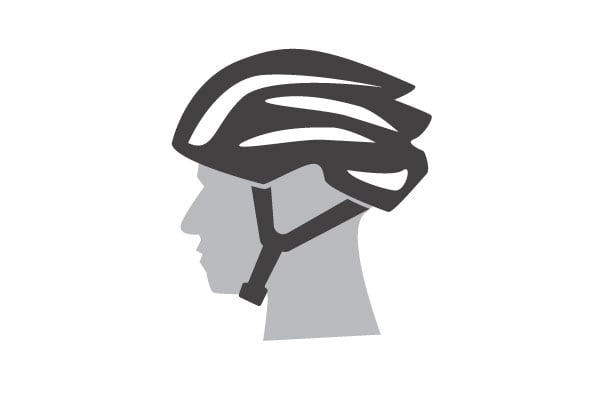
Many people don’t consider how the straps of their bike helmet fit, but this is important for both comfort and function. You’ll want to buckle the clasp under your chin and adjust the strap so that you can just fit one finger between the strap and your neck. You’ll want to be able to open your mouth and tilt your head back with only slight pressure from the strap, but without choking you. This “wiggle room” will allow you to ride comfortably while still holding the bike helmet in place in case of a crash. Don’t forget to adjust the straps around your ears. These should form a ‘V’ around your ears and meet just below your ear lobes
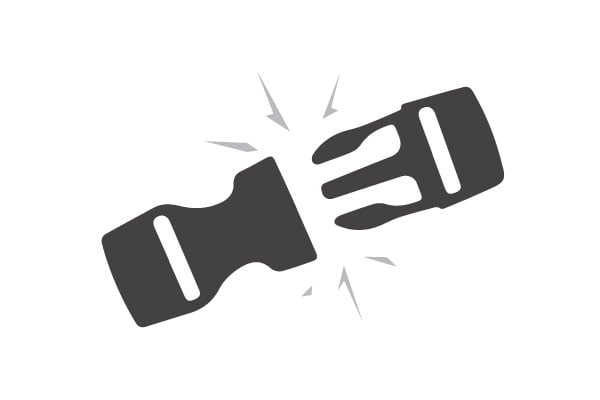
This test is a great way to ensure that your bike helmet fits properly, and all the retention devices are adjusted correctly. Simply shake your head side to side, up down, and around. If your bike helmet moves too dramatically during any of these movements, adjust the retention system to remedy the movement. If you’re retention system is maxed out, you likely need a different sized bike helmet.
RIDE READYOnce you’ve ensured a solid fit, you are ready to ride with your new bike helmet. Be sure to check your fit adjustments before each ride as straps and retention systems can loosen during use or travel. A simple wiggle of your head or push of your hand will indicate if your bike helmet is good-to-go or needs a quick adjustment.
Most mid to high-level bike helmets will feature some sort of ratcheting or dial fit system. These are most commonly adjusted using some sort of knob at the back of your head that lets you dial in the precise sizing of the bike helmet retention system. Not only does this increase comfort, but it also allows for slimmer bike helmet profiles and reduced sized pads. It further holds the bike helmet properly in place during a crash
REMOVABLE PADSRemovable pads are often found in lower tier helmets or in youth kids bike helmets. Many downhill mountain bike helmets use this sizing method as well since a ratcheting system can be very challenging to incorporate. Bike helmets are supplied with multiple pad sizes to adjust the fit.
SHOP BIKE HELMETSThe search for balance between protection and ventilation is a crucial one. If a bike helmet doesn’t breathe well, you will be less likely to use it consistently. At the same time, you need to have ample protection for your riding protection. Bike helmet brands continue to improve this balance, and modern bicycle helmets all have some version of ventilation that draws air across your head and expels the sweaty air out the back. Since the needs of ventilation and protection vary for each riding discipline it is important to shop for bicycle helmets that match your riding needs.
There are two primary types of bike helmet styles; half shell and full face. A half shell bike helmet covers the upper and back portion of your head, while a full face protects your entire head with an included chin protector
The majority of bike helmets will land in the half shell category including road, commuter/urban, MTB, and BMX style bike helmets. These bike helmets run a wide range of designs and builds that are distinct for the type of riding they are intended for. Road bike helmets put more focus on venting, aerodynamics, light weight, and provide a bit less coverage. Mountain bike helmets emphasize more coverage and protection for the back, temples, and jaw areas of the head and loads of ventilation. MTB helmets tend to be somewhat heavier due to the types of impacts that they must protect against.
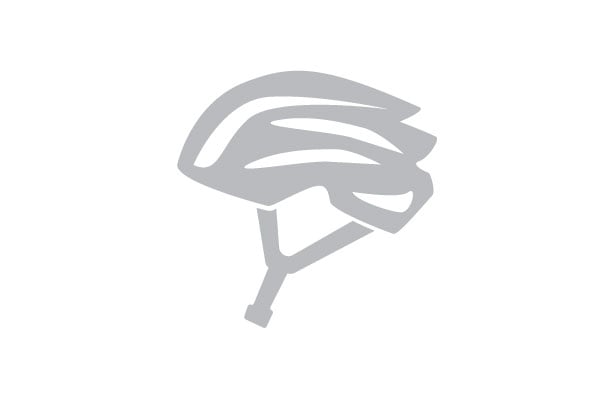
Full face mountain bike helmets provide maximum protection but make sacrifices in weight and ventilation. They are the best choice for gravity-oriented riders and those who love to get boosty on their bikes. Full face mountain bike helmets are currently gaining in popularity for enduro riders. This has grown thanks to a new batch of lighter weight and better ventilated (lighter duty) full face mountain bike helmets and the rise of convertible bike helmets that have a removable chin protector.

There are several Helmet types designed for multiple and specific cycling disciplines, each with unique features. Below are examples of helmets by usage.
Recreational bike helmets are aimed at the casual rider that may prioritize value over light weight or exotic materials. These bike helmets still pass all rigorous safety standards. What you might miss are the additional air vents or higher end straps and clips. Many of the bike helmets at this level feature a universal fit to help save money.
Commuter bike helmets will share many qualities with the recreational helmets but may offer a couple of specific features that make them unique. Integrated visors help shield the eyes from early morning light. More specifically, some commuter bike helmets offer either an integrated rear bike light “tail light” or attachment area to clip on a bike light to add visibility to motorists.
SHOP RECREATIONAL & COMMUTER BIKE HELMETS
Road bike riders look for light weight and airy bike helmets to keep them comfortable and performing at the highest level during their regular rides. Most of these bike helmets will have light weight adjustable retention systems and anti-microbial liners and pads. Aero road helmets are a fairly new to this segment and will feature better aerodynamics at the expense of ventilation
SHOP ROAD BIKE HELMETS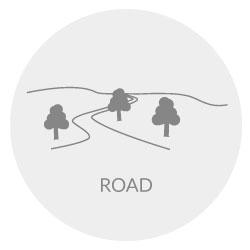
RMountain bike helmet construction is similar to road bike helmets but features a visor and increased safety coverage in the rear. As the riding becomes faster and more extreme, helmets will have increased protection from the rougher terrain. At the highest level of protection will be full face mountain bike helmets that offer additional protection that wraps around the front of the face. These bike helmets are popular with downhill mountain bikers and riders that ride primarily at bike parks.
There has been a trend in the enduro racing community to wear bike helmets with a removable chin bar that will allow the rider to have the safety of a full-face mountain bike helmet when riding downhill, but also the ventilation of a standard trail helmet when they are riding to the top of the climb. Several of the newer bike helmets are actually very lightweight and ventilated helmets that are still protective but offer plenty of air flow when riding to the top of the climb.
SHOP MOUNTAIN BIKE HELMETS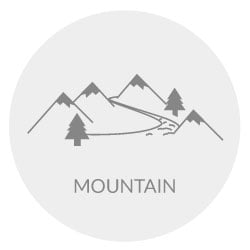
It’s important to know that all the fit rules that we described above apply when purchasing kids bike helmets, but there are some additional considerations to be aware of. Very young kids may not be able to properly describe the fit or comfort of their bike helmet. Be mindful of any complaints they may share to give you clues towards proper sizing. Further, do not buy a bike helmet with “room to grow.” An overly-large bike helmet does not provide proper protection. Helmet manufactures often provide additional pads or adjustable fit systems that allow your child’s head to grow while working within the helmets functional range.
Young riders have numerous options to choose from. Manufacturers will provide very young riders with bright graphics that appeal to those young kids getting their first helmet when they start their bike riding adventures. These bike helmets will feature adjustable straps as well as universal fit that will grow with them. Most of these bike helmets are lightweight, easy to adjust and fit children’s heads that range from 46-54cm around.
As children get older, they may be looking to wear bike helmets that look more like what the bigger and older riders are wearing, and their speeds are increasing adding to the need for more protection. Sizes may move away from universal fits to a more specific youth size range to offer a more precise fit. Many of the safety features found on adult bike helmets will also trickle down to the kids bike helmets.
SHOP KIDS HELMETSOnce you have your bicycle helmet chosen, how long should you keep it? That will depend on many factors. Do know that if you crash, that is a perfect time to replace the helmet. The foam and other materials used in the construction of the helmets are designed to absorb the force of the impact and will not be able to be reused. If you have any questions, please call our Gear Advisors or your local bike shop.
Maybe you have never crashed and your day-glo helmet from the 80’s just looks a little dusty. Should be fine right? Unfortunately, the sun and the elements will weaken the effectiveness of the helmet over the years. Replacing your helmet every 3-5 years is recommended as you will gain the advantage of all the new technology as well without worrying if your helmet is “too old”. Lastly, do not use any harsh chemicals or cleaners on your helmet. These can shorten the life of the materials. Mild soap and water works great to get it looking and smelling fresh again.
SHOP HELMET ACCESSORIESA major part of choosing the right bicycle helmet for your needs is understanding how a bike helmet is constructed and what type of technologies are being used. Build techniques and tech can affect price, performance, safety, and weight. We’ve put together this glossary to help you out.
Helmet manufacturers use two primary types of bike helmet construction; in-mold and hard shell. The choice of which method is largely determined by the intended usage of the helmet.
Closely connected to the bike helmet construction, are the technologies and testing standards that help to ensure that your helmet will protect your brain. In the US, there are several standards put forth by the Consumer Products Safety Commission and also the Snell Foundation. These tests are designed to ensure that qualifying helmets pass a set of tests to ensure a high-level of protection. Look for a CPSC sticker on any bike helmet you buy. Other safety standards include:
*Helmet safety standards information is from www.helmetfacts.com/standards
Additional Protection TechWithin the past few years, there has been increased awareness in protecting the brain from rotational forces during a crash. The idea is to provide a slip-plane between the bike helmet and head that allows the head to move just a bit inside the helmet thus slowing rotational forces transferred to the brain. The most common slip-plane technology is MIPS (Multi-directional Impact Protection System), but there are several other alternatives from various manufactures. The principle is generally the same with various executions. We look forward to new testing that clearly demonstrate the benefits of each system. Slip-plane technology includes:
SAVE 20% ON FIDLOCK
SHOP NOW
SHIP ALMOST ANYTHING & SAVE
SHOP NOW